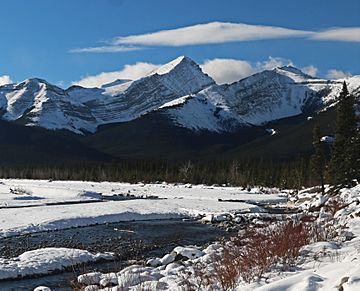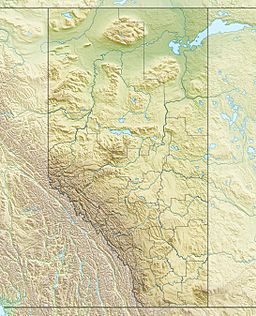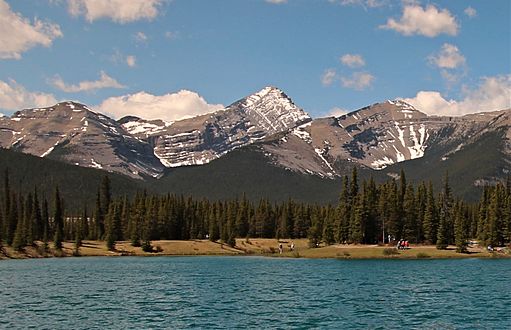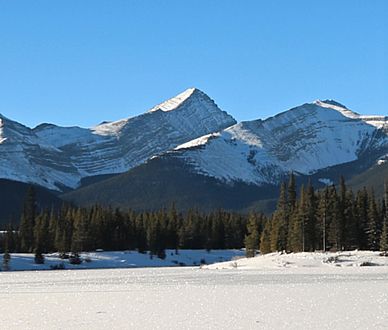Mount Glasgow facts for kids
Quick facts for kids Mount Glasgow |
|
|---|---|

Mount Glasgow seen from Elbow River valley
|
|
| Highest point | |
| Elevation | 2,935 m (9,629 ft) |
| Prominence | 283 m (928 ft) |
| Parent peak | Mount Cornwall (2970 m) |
| Listing | Mountains of Alberta |
| Geography | |
| Location | Alberta, Canada |
| Parent range | Opal Range Canadian Rockies |
| Topo map | NTS 82J/15 |
| Geology | |
| Age of rock | Cambrian |
| Type of rock | limestone |
| Climbing | |
| First ascent | 1949, A Choquette |
| Easiest route | Scramble East and west ridges |
Mount Glasgow is a tall, pyramid-shaped mountain in the Canadian Rockies. It stands about 2,935-metre (9,629 ft) (9,629 feet) high. You can find it in Kananaskis Country, Alberta, Canada.
The mountain is located between the Elbow River valley and the Little Elbow River valley. On a clear day, you might even be able to see it from the city of Calgary. The closest taller mountain to Mount Glasgow is Mount Cornwall, which is about 2.0 km (1.2 mi) to the southwest.
Contents
History of Mount Glasgow
Early Explorers and Naming
The first non-native person to explore southern Alberta was Peter Fidler. He saw this mountain and thought it looked like a pyramid. He even wrote that he would call it "Pyramid." This was the first time a non-native person named a peak in the Canadian Rockies.
However, the name "Pyramid" did not stay. In 1922, the mountain was officially named Mount Glasgow. It was named after HMS Glasgow, a British warship. This ship was part of an important battle called the Battle of the Falkland Islands during the First World War. The name became official in 1939.
First Climbers
The first time someone successfully climbed to the top of Mount Glasgow was in 1949. An explorer named Arnold Choquette made this first ascent.
How Mount Glasgow Was Formed (Geology)
Mount Glasgow is made of sedimentary rock. This type of rock forms from layers of sand, mud, and tiny bits of sea creatures that settle over millions of years. The rocks that make up Mount Glasgow were laid down a very long time ago, between the Precambrian and Jurassic periods.
These layers of rock were formed in shallow seas. Later, during a time called the Laramide orogeny, huge forces pushed the Earth's crust. This caused the sedimentary rock to fold and lift up, creating the mountains we see today. The rocks of Mount Glasgow were pushed eastward and stacked on top of younger rock layers.
Weather and Climate
Mount Glasgow is in a subarctic climate zone. This means it has very cold winters with lots of snow. The summers are usually mild. Temperatures can drop below −20 °C (−4 °F) (which is -4°F). With the wind, it can feel even colder, sometimes below −30 °C (−22 °F) (-22°F).
The water from melting snow and rain on the mountain flows into the Elbow River. The Elbow River then flows into the Bow River.
Gallery






